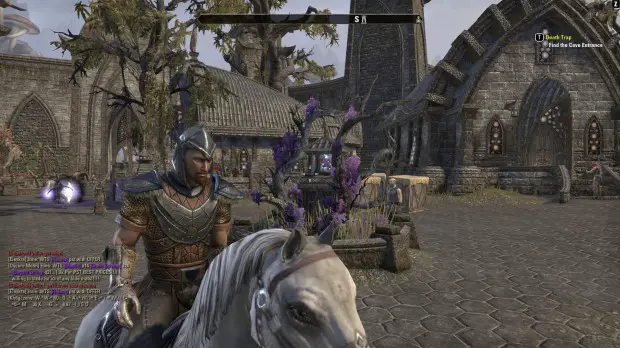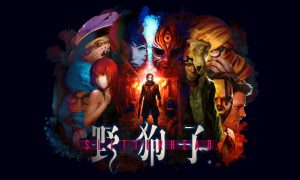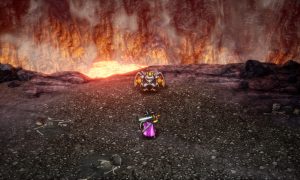There are very few properties across any franchise that can say that they’ve snared players for nearly (or even over) 1000 hours. The Elder Scrolls can make that claim, and without too much effort. Arena, Daggerfall, Battlespire, Redguard, Morrowind, Oblivion, and Skyrim have truly created worlds. Each distinctly unique from one another, they also provided complex socio-political commentary couched in an RPG with incredible freedom. Playing as a Khajiit might make you think about racism, you’ll encounter religion and religious war, and each of nine provinces of Tamriel are in a constant power struggle to seat one of their own on the Throne of the Empire. How you deal with all of these situations are just as important as how you stop whatever overwhelming evil has befallen the world. It’s these challenges that make an Elder Scrolls game.
After forming a new team called Zenimax Online, Bethesda set out to do something surprising – unify the experiences set forth by all previous titles into one massively multiplayer world. Centered around the empty throne of Cyrodil and the battle to seize it, The Elder Scrolls Online pits the Ebonheart Pact, the Daggerfall Covenant, and the Adlmeri Dominion against one another in a nationwide epic struggle. Ambitious? Damned right. I set out to see if this lofty goal could be met while still somehow retaining the single player aspects that make an Elder Scrolls game great.

Before we get too far down this skeever hole, I’ll be upfront about the status of my characters. I played the Beta throughout and then played several characters upon release. I may not have reached the final tiers of the endgame yet, but I have more than enough hours to justify a review that encapsulates what most people will experience in The Elder Scrolls Online. I’m also going to tackle PvP separately as I believe the bulk of players will be interested in the PvE content more than the war for the throne. Expect that follow-up later.
The long-running tradition of starting your character as a jail-bound reprobate continues here, but with a twist. For whatever reason you’ve not only been sent to the slammer, but you’ve also had your soul ripped out and shot deep into Oblivion. Your destiny – eternal damnation and torment. But hey, at least you’ve got your health, right?! Cheery introduction aside, naturally you are the chosen one and Dumbledore…er..I mean The Prophet. He releases you from your cell and guides you throughout your journey to recover your soul, and well beyond that goal. Describing where you go from there is like trying to count stars in the night sky – this game is BIG.

The first thing you’ll do is build your character. The level progression is far slower than you’ve likely experienced in most MMOs, so this is an ass you’ll be spending a great deal of time watching, so choose wisely. With your character selected (and customized in typical Elder Scrolls fashion), you’ll choose from four classes. That’s right, only four. Unlike most RPGs, you won’t be locked into a tightly-controlled class structure, instead selecting from four archetypes; Templar, Dragon Knight, Sorcerer, and Nightblade. In more casual parlance these might be described as Cleric, Fighter, Mage, and Thief, but that’d be a huge disservice to what’s going on under the surface.
Each class has depth far beyond the typical tropes. Taking the Templar as an example, there are three huge trees of skills that you can select from, creating specialization or generalization as you spend your valuable skill points. You can chose Aedric Spear, Dawn’s Wrath, and Restoring Light. Aedric Spear is composed of offensive powers, giving you powerful attacks and interrupts. Dawn’s Wrath unleashes the power of the Sun against your enemies, setting them on fire and doing damage over time. Restoring Light is your healing skill set, mending wounds, buffing, and cleansing your allies of negative effects. You can mix and match all three sets of powers as you see fit, but you’ll always have five active, four passive, and one ultimate power. The ultimate power is charged up as you use your active skills and engage in combat, making them an infrequent and aptly named trait. Beyond these skills, each power can also be morphed after frequently using them for a period of time. Morphing offers you two different options with two trait trees that change how that power is used. For instance, morphing a power may take it from being a two second cast time to an instant, or it may cause you regenerate stamina. There are so many possible combinations that no two characters are likely built the same.

Beyond the class skills there is a massive tree of goodies to uncover. Crafting, Armor, Weapons, World, Racial, Class, and Guild skills all expand to show dozens of options to further customize your character. Do you want to specialize in Soul Stone magic to recharge magical weapons and armor? Would you rather craft Leather goods and sell them? Do you like to cook or brew potions? How about reducing the penalty to dual wielding? Since there are literally no restrictions on armor or weapon use regardless of class, you can build any character type you’d like, just like in any single player Elder Scrolls title. Like those single player titles, you’ll also gain health, magicka, and stamina. If you feel the need (and you likely will) you’ll be able to respect both sets of points, albeit for a progressively more expensive cost.
Now that we’ve talked about skills we can dig into combat. Most MMOs have devolved into simply pressing the right number key at the right time while standing blissfully stupid in front of your prey. Some more active MMOs have implemented a dodge and block mechanic. The Elder Scrolls Online has blended the latter with the combat systems of the single player game. Area of effect attacks will light up a red disc under their feet to designate the radius. Melee attacks. When an enemy charges up their special attack there is a bit of a highlight that allows you to block an incoming melee strike or shoulder/shield bash a caster to interrupt them. Attacking at that moment will often take the target off their feet, allowing you a few precious seconds to capitalize on the opening. Spells operate in a pretty much bog-standard method you’ve seen in other titles, but with the likelihood you’ve selected other skills that’s just fine.
The combat in The Elder Scrolls Online is pretty aggressively tough. You can get in over your head if you aren’t paying attention, and enemies are just as capable and powerful as you are, unleashing powers similar to your own. The great thing is that they are carefully thought out, putting the proper creatures into the eight distinct habitats (the ninth, Cyrodill, is the PvP area). A great many of these creatures had to be built specifically for the game as they have only existed in the early Elder Scrolls titles – it’s great to see them come to life. The problem? Repetition. It’s not “kill eight fuzzy bunnies” early days of World of Warcraft repetitive, it’s just killing a lot of the same types of creatures, over and over.
Speaking of repetition, let’s dig into the meat and potatoes of any good RPG – quests. There aren’t a bunch of NPCs sitting around with punctuation above their heads waiting for you to come and solve their issues. In this case, you’ll encounter NPCs standing around waiting for you to come and solve their issues as indicated on the world HUD like you might have in Skyrim. The hiccup here is that the team committed to such an incredibly large world that at some point in the process they started using the “clone” tool. While all quests are fully voiced, a great many are very similar. Go here, click a piece of paper, come back and talk to me again. Ok, take that piece of paper and go across town and talk to somebody else. I don’t mind delivery quests, but given that it’s estimated that TESO has over 1 million subscribers at this point, that path to and from begins to look like a Los Angeles highway.
Suppose for a moment that you work through a large area quest, discovering an area is being suppressed by some rogue force. You do the aforementioned fetching and are sent to kill some foes. You get there and find four of five people standing around waiting to kill them too. You can jump in without grouping and help, still getting credit and loot, but it hardly feels like your quest at that point. When you finally reach the boss and find half a dozen people have cleared the entire path through the dungeon to reach him, and a half a dozen more are standing there waiting for the boss to spawn, farming him over and over, the rose is officially off the bloom. Your only option is to join the pack and try to get a strike or two in to get enough credit to move on. When it’s simpler, asking you to pick up a bucket and put out a fire, it just looks stupid when 15 people in front of you just did the same thing. The problem with any MMO is the people, but that’s not all that’s at play here. Behold the rise of the bot.

Botting is nothing new to the MMO space. Ever since people figured out that they could farm gold and then sell it for real money, those same people have used very intelligent scripting to level up characters, camp and farm resource nodes, and even engage in combat. Sometimes so convincingly that you don’t even realize that they aren’t human. In TESO there is such an abundance of bots that it exacerbates the population control issue drastically. The team at Zenimax Online are committed to killing them off, even assigning roving GMs to crush them as they pop up like some twisted game of whack-a-farmer, but there seems to be an alarming number still.
The Elder Scrolls Online is rock solid in terms of presentation. The character models are incredibly detailed, as are the environments in each of the areas of the game. Each province within Tamriel is unique in terms of architecture, flora, and fauna. The cities range widely from little fishing villages to expansive capital cities that seem to go on forever. These areas are frequently aggregation points for players, creating visual blights like bankers with more than 100 people surrounding them, but they also serve as the central hubs for each faction. There are beautiful horizons, dynamic weather, and amazing sunrises as the world continues to spin around you. Water and trees look solid, as do the great variety of armor sets….at least once you put them together. (there is still the ‘crazy clown look’ inherent in mixing and matching armor, as in any RPG) It’s not as gorgeous as the insane mods that you can attach to Skyrim, but it’ll also run on fairly moderate hardware. Visually, you won’t be disappointed.
The Elder Scrolls series has always had incredible audio production, often worthy of a soundtrack purchase. The Elder Scrolls Online is no exception to this rule, giving us fantastic music to guide us through our adventures. Another thing the series has been known for is horrific voice repetition. While I can say that I’m not hearing nearly as much voice hiccups, it is odd to hear some of the same voices in several disparate towns. There are celebrities attached to TESO beyond Michael Gambon (Dumbledore from Harry Potter), including the always-awesome John Cleese (Monty Python), Bill Nighy (Shaun of the Dead), Kate Beckinsale (Underworld), Alfred Molina (Spider-Man 2), Malcolm McDowell (A Clockwork Orange, Wing Commander, Caligula) and Lynda Carter (Wonder Woman). You’ll also run across the female Commander Shepard (Jennifer Hale) fairly quickly into your story. Additionally you’ll find folks like Kevin Michael Richardson (way too many to list), Peter Stormare (Armageddon, The Big Lebowski, Fargo), Jim Ward (Diablo III, Dragon Age II, Ratchet & Clank series), and Gideon Emery (Dragon Age II, God of War: Ascension, Rocksmith) just to name a few. Bethesda and Zenimax Online have assembled a powerhouse of voice actors, and it pays dividends.

One thing that surprised me was the inclusion of mod support. While games like World of Warcraft embraced modders not too long after launch, TESO has baked this directly into the game from the start. There are all sorts of functionality-enhancing mods already available, and I can imagine that it’s only a matter of time before that same modding engine enables the crazy texture business I mentioned above.
My personal favorite thing to do in any RPG is crafting. I love baking bread, smithing armor, and creating things. The Elder Scrolls games have always had robust crafting options, and that holds true here as well. You can build daggers, swords, mauls, magic wands, bows, shields, and so much more in the various styles of the realm, once you gather the right materials. While there are camped nodes (see the bot notes), materials are fairly plentiful in the game, giving ample opportunity to participate in the crafting system. Once you navigate the cumbersome UI you will be crafting daggers in no time. I pounded out hundreds of such daggers, watching my XP meter and skill in smithing slowly climb. It’s at that point that I found out about trading. You see, you can deconstruct any items you find or make for additional experience in the selected crafting skill. That said, if you trade a bunch of daggers to somebody else for their crafted daggers, suddenly you get ten times the amount of experience. This doesn’t make logical sense in any way, but it is the case. It also uncovers the pain of the economy and more wonky UI elements.

Let’s suppose you are trading 30 daggers to another player to bump your smithing skill. Since you can’t stack the daggers you can only push them into the trading window one at a time until you get to five – that’s all you can swap at one time. The same happens when you try to put things into your bank, or your guild’s bank. In fact, some items are stackable and some are not. You can stack up to 100 Iron Ingots, but you can’t stack two of the same armor. Worse yet, when you put those items into your guild bank they are treated independently, meaning you may have a stack of five health potions sitting right next to another stack of seven of the same thing. This means picking the most OCD-afflicted amongst your guild to routinely go in and remove everything into their inventory to stack them together and then put them back so as to not fill up your limited bank space. I’m certain this can be fixed in time, but it points to more elements of the cumbersome UI. This is only made worse by the lack of an Auction House.
The Elder Scrolls Online has focused hard on the player-based economy. They expect that players will trade amongst themselves or craft their own gear rather than buy and sell it in an Auction House. As such, there is no way to sell off your goods but to shout it in General Chat, or to drop it with a vendor. This leaves the entire population fairly impoverished by comparison to their level. It also makes General Chat into a trading zone since there is no designated space for that activity.

Around level 15 or so you’ll want to start partnering up to tackle instanced dungeons. There is a built-in Looking for Group system that allows you to designate player levels and class. This would work in any other MMO, but since everyone can mix and match their skills in completely unique configurations, it muddies the water quite a bit. You’ll still see people calling for the traditional roles of healer, tank, etc., but once you’ve grouped up you’ll find that it’s not quite as cut and dry as you are used to. As a result, dungeons are brutally difficult, often wiping out the entire team repeatedly. You can pop back to the beginning of the dungeon and force your way through for the most part, but it means a lot of equipment durability loss and a lot of frustrating wasted time to reassemble your party. To fix this, fight along side friends that know their class.
I guess that’s the most difficult part of The Elder Scrolls Online – I don’t know where I belong. In other MMOs I knew what role I served in a party, and I felt like I knew what my path was. Here I’m overwhelmed by options that lead me down a path that inevitably will lead me to frequent and expensive respeccing. But here’s the good news…

Despite everything I’ve said above, somehow I’m still having fun in Tamriel. The game had a rough launch with network hiccups, but far less than other launches. I’ve seen lag bubbles, but not nearly as many as I’ve seen in other titles. Every week Zenimax Online has pushed patches that address large swaths of community complaints. The game is clunky, and the UI is rather painful, but somehow I’m still enjoying my time in this world. My worry is the overall quest structure.
One of the big lures of this title is that, despite three factions, players can max out their level and then switch sides. They’d then be able to tackle a rival faction with their existing character and enjoy all of the content there as well. Once they’ve completed both they could then take on the third section of the game. These quest ‘flash mobs’ are such a huge design oversight that I’m not sure how, or if, they can be fixed. While I’m enjoying my first run through my faction, I’m not sure I would want to deal with the same public rush quests on another section of the continent.
Ron Burke is the Editor in Chief for Gaming Trend. Currently living in Fort Worth, Texas, Ron is an old-school gamer who enjoys CRPGs, action/adventure, platformers, music games, and has recently gotten into tabletop gaming.
Ron is also a fourth degree black belt, with a Master's rank in Matsumura Seito Shōrin-ryū, Moo Duk Kwan Tang Soo Do, Universal Tang Soo Do Alliance, and International Tang Soo Do Federation. He also holds ranks in several other styles in his search to be a well-rounded fighter.
Ron has been married to Gaming Trend Editor, Laura Burke, for 28 years. They have three dogs - Pazuzu (Irish Terrier), Atë, and Calliope (both Australian Kelpie/Pit Bull mixes), and an Axolotl named Dagon!

So here we are at the end of a very long review for a very big game, and the question of whether or not The Elder Scrolls Online has captured the magic of its single single contemporaries still remains to be answered. I think the framework is there, but there are some painful missteps that are holding it back. MMOs are a constantly evolving ecospace, so it’s possible we’ll get there, but for now I’ll cautiously say…maybe.
PROS
- Lockpicking and crafting are fun!
- Incredible variety of build options
- Crafting feels worthwhile
- Stable with a solid network implementation
- Graphically beautiful
CONS
- Grouping system is awful
- Quests devolve into flash mobs
- UI is painful in MANY places
- Repetition is rampant
- Bots...so many bots
See below for our list of partners and affiliates:

























